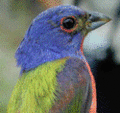Hue facts for kids
Hue is one of the main ways we describe a color. It helps us tell if a color is more like red, green, blue, or yellow. Think of it as the pure color itself.
Other important parts of a color are how bright it is (called lightness or brightness), and how strong or vivid it is (called chroma or saturation).
When colors have the same hue, we often use words like "light blue," "pastel blue," or "vivid blue" to show how different they are in brightness or strength.
Contents
What is Hue?
Hue is what makes us see a color as red, orange, yellow, green, blue, or purple. Imagine a color wheel. Each point on the wheel represents a different hue. Red is on one side, green on another, and blue somewhere else.
It's how much a color looks like one of the "main" colors. These main colors are red, green, blue, and yellow. For example, orange is a hue that is between red and yellow.
How We See Hues
Our eyes have special cells called cones. These cones help us see different colors. They are sensitive to red, green, and blue light. Our brain then mixes these signals to create all the colors we see.
When light hits an object, some colors are absorbed and some are reflected. The reflected light enters our eyes. The hue we see depends on which wavelengths of light are reflected.
Hue in Art and Design
Artists and designers use hue all the time. They pick specific hues to create different moods or feelings. For example, warm hues like red and orange can feel energetic. Cool hues like blue and green can feel calm.
Understanding hue helps them mix paints or choose colors for websites. They can create color schemes that look good together.
Hue and Color Models
Scientists and computer experts use different ways to describe colors. These are called color models. Two common models that use hue are HSL and HSV.
HSL Color Model
HSL stands for Hue, Saturation, and Lightness.
- Hue is the color itself, like red or blue.
- Saturation is how pure or intense the color is. A highly saturated color is vivid. A less saturated color looks more gray.
- Lightness is how bright or dark the color is. A high lightness means a bright color. A low lightness means a dark color.
HSV Color Model
HSV stands for Hue, Saturation, and Value. Value is similar to lightness.
- Hue is the color, just like in HSL.
- Saturation is the purity of the color.
- Value is the brightness of the color. It describes how much light is in the color.
These models help computers display colors correctly. They also help designers pick exact colors for their projects.
Images for kids
-
All colors on this color wheel should appear to have the same lightness and the same saturation, differing only by hue
-
The colors in this image of a painted bunting bird change over time
See also
 In Spanish: Tono (color) para niños
In Spanish: Tono (color) para niños







